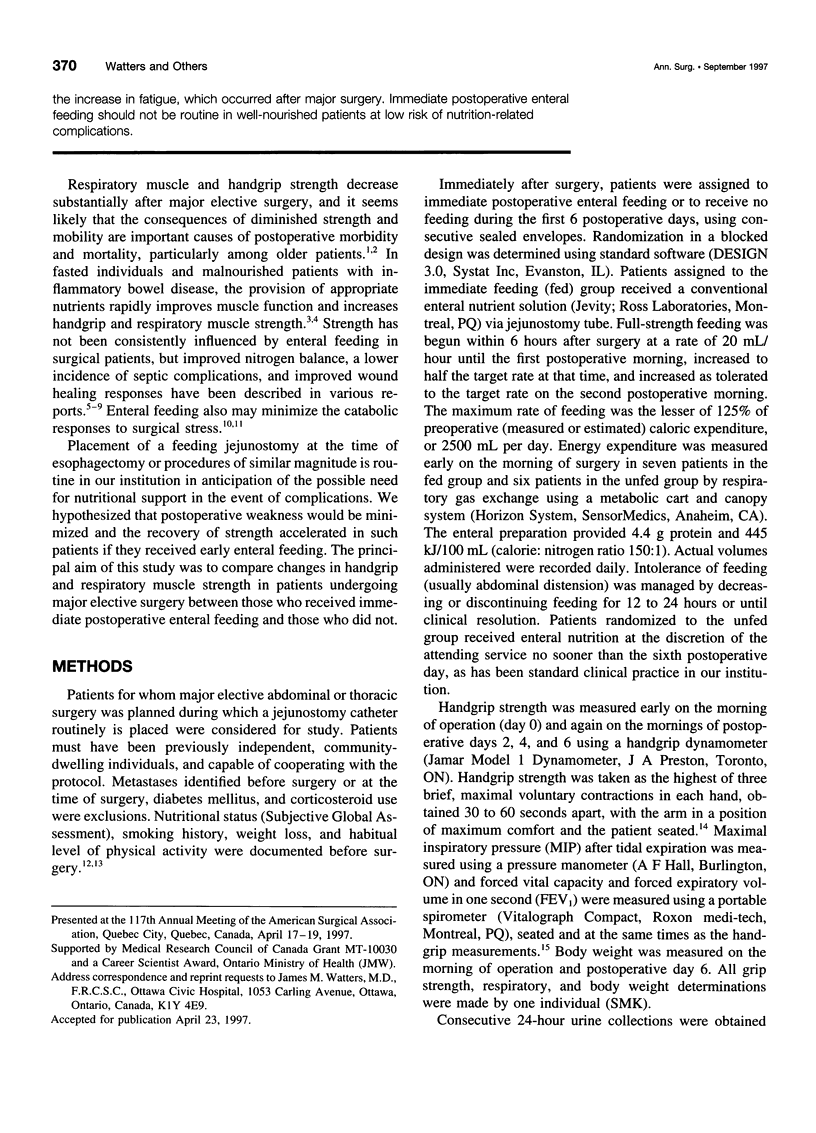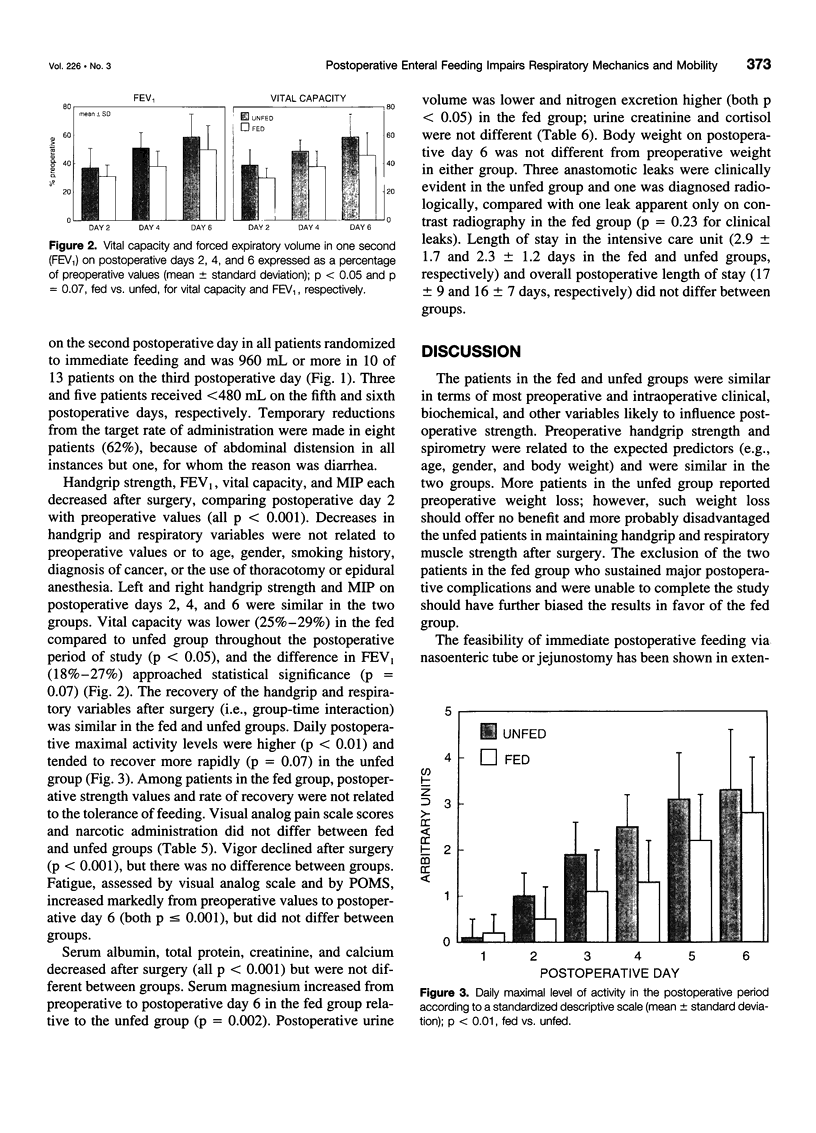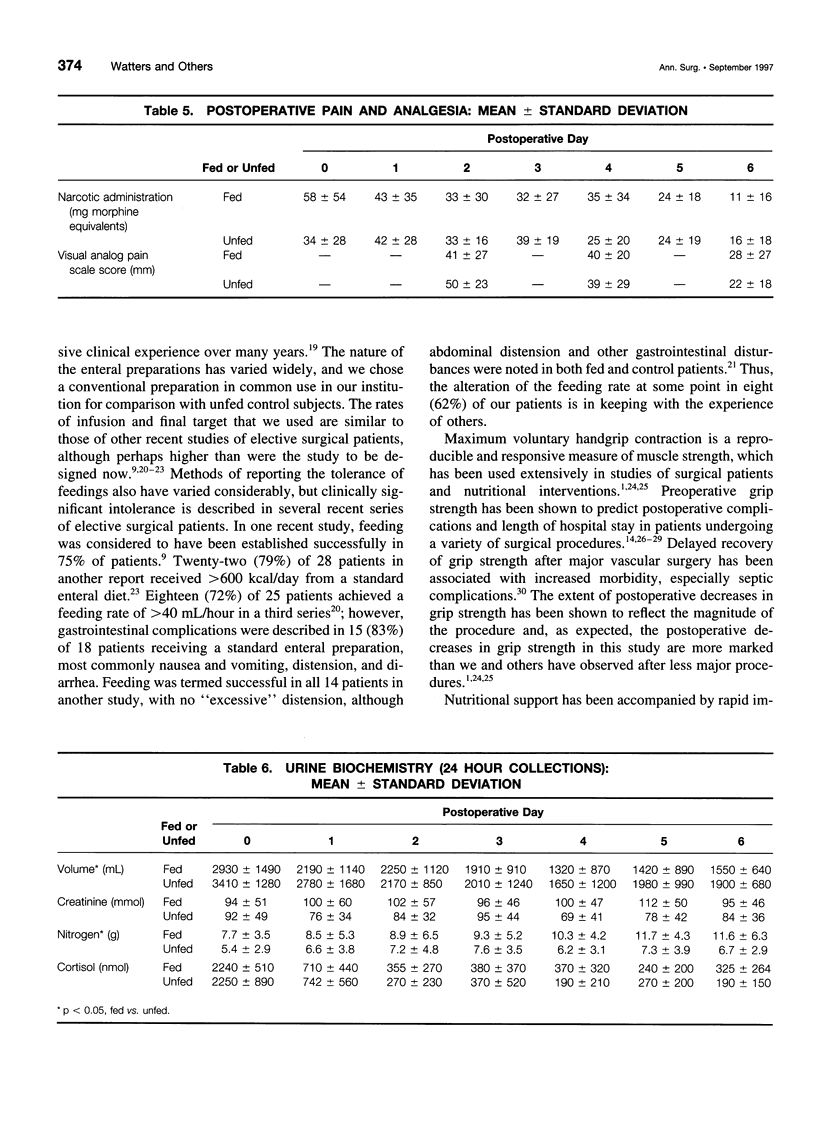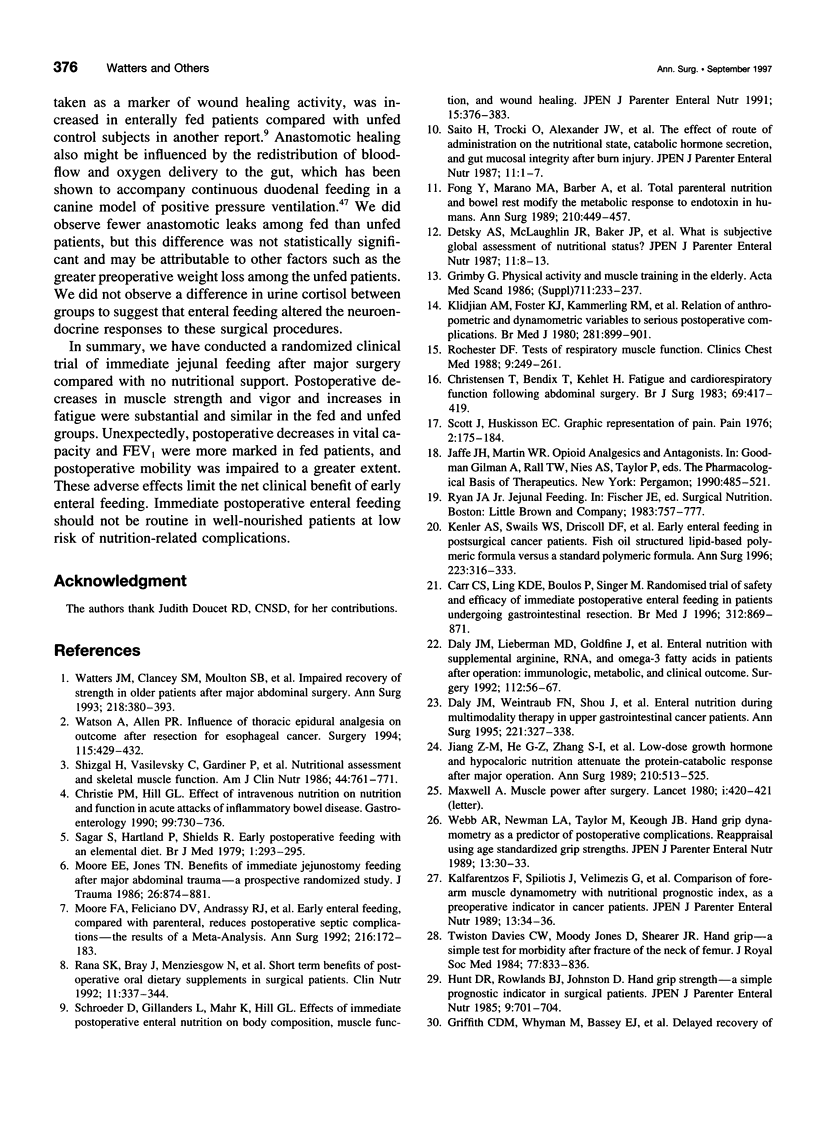Abstract
OBJECTIVE: The authors set out to determine whether immediate enteral feeding minimizes early postoperative decreases in handgrip and respiratory muscle strength. SUMMARY BACKGROUND DATA: Muscle strength decreases considerably after major surgical procedures. Enteral feeding has been shown to restore strength rapidly in other clinical settings. METHODS: A randomized, controlled, nonblinded clinical trial was conducted in patients undergoing esophagectomy or pancreatoduodenectomy who received immediate postoperative enteral feeding via jejunostomy (fed, n = 13), or no enteral feeding during the first 6 postoperative days (unfed, n = 15). Handgrip strength, vital capacity, forced expiratory volume in one second (FEV1), and maximal inspiratory pressure (MIP) were measured before surgery and on postoperative days 2, 4, and 6. Fatigue and vigor were evaluated before surgery and on postoperative day 6. Mobility was assessed daily after surgery using a standardized descriptive scale. Postoperative urine biochemistry was evaluated in daily 24-hour collections. RESULTS: Postoperative vital capacity (p < 0.05) and FEV1 (p = 0.07) were consistently lower (18%-29%) in the fed group than in the unfed group, whereas grip strength and maximal inspiratory pressure were not significantly different. Postoperative mobility also was lower in the fed patients (p < 0.05) and tended to recover less rapidly (p = 0.07). Fatigue increased and vigor decreased after surgery (both p < or = 0.001), but changes were similar in the fed and unfed groups. Intensive care unit and postoperative hospital stay did not differ between groups. CONCLUSIONS: Immediate postoperative jejunal feeding was associated with impaired respiratory mechanics and postoperative mobility and did not influence the loss of muscle strength or the increase in fatigue, which occurred after major surgery. Immediate postoperative enteral feeding should not be routine in well-nourished patients at low risk of nutrition-related complications.
Full text
PDF








Images in this article
Selected References
These references are in PubMed. This may not be the complete list of references from this article.
- Brandi L. S., Bertolini R., Janni A., Gioia A., Angeletti C. A. Energy metabolism of thoracic surgical patients in the early postoperative period. Effect of posture. Chest. 1996 Mar;109(3):630–637. doi: 10.1378/chest.109.3.630. [DOI] [PubMed] [Google Scholar]
- Carr C. S., Ling K. D., Boulos P., Singer M. Randomised trial of safety and efficacy of immediate postoperative enteral feeding in patients undergoing gastrointestinal resection. BMJ. 1996 Apr 6;312(7035):869–871. doi: 10.1136/bmj.312.7035.869. [DOI] [PMC free article] [PubMed] [Google Scholar]
- Christensen T., Bendix T., Kehlet H. Fatigue and cardiorespiratory function following abdominal surgery. Br J Surg. 1982 Jul;69(7):417–419. doi: 10.1002/bjs.1800690721. [DOI] [PubMed] [Google Scholar]
- Christie P. M., Hill G. L. Effect of intravenous nutrition on nutrition and function in acute attacks of inflammatory bowel disease. Gastroenterology. 1990 Sep;99(3):730–736. doi: 10.1016/0016-5085(90)90962-z. [DOI] [PubMed] [Google Scholar]
- Craig D. B. Postoperative recovery of pulmonary function. Anesth Analg. 1981 Jan;60(1):46–52. [PubMed] [Google Scholar]
- Craig D. B., Wahba W. M., Don H. F., Couture J. G., Becklake M. R. "Closing volume" and its relationship to gas exchange in seated and supine positions. J Appl Physiol. 1971 Nov;31(5):717–721. doi: 10.1152/jappl.1971.31.5.717. [DOI] [PubMed] [Google Scholar]
- Daly J. M., Lieberman M. D., Goldfine J., Shou J., Weintraub F., Rosato E. F., Lavin P. Enteral nutrition with supplemental arginine, RNA, and omega-3 fatty acids in patients after operation: immunologic, metabolic, and clinical outcome. Surgery. 1992 Jul;112(1):56–67. [PubMed] [Google Scholar]
- Daly J. M., Weintraub F. N., Shou J., Rosato E. F., Lucia M. Enteral nutrition during multimodality therapy in upper gastrointestinal cancer patients. Ann Surg. 1995 Apr;221(4):327–338. doi: 10.1097/00000658-199504000-00002. [DOI] [PMC free article] [PubMed] [Google Scholar]
- Davies C. W., Jones D. M., Shearer J. R. Hand grip--a simple test for morbidity after fracture of the neck of femur. J R Soc Med. 1984 Oct;77(10):833–836. doi: 10.1177/014107688407701006. [DOI] [PMC free article] [PubMed] [Google Scholar]
- Detsky A. S., McLaughlin J. R., Baker J. P., Johnston N., Whittaker S., Mendelson R. A., Jeejeebhoy K. N. What is subjective global assessment of nutritional status? JPEN J Parenter Enteral Nutr. 1987 Jan-Feb;11(1):8–13. doi: 10.1177/014860718701100108. [DOI] [PubMed] [Google Scholar]
- Fong Y. M., Marano M. A., Barber A., He W., Moldawer L. L., Bushman E. D., Coyle S. M., Shires G. T., Lowry S. F. Total parenteral nutrition and bowel rest modify the metabolic response to endotoxin in humans. Ann Surg. 1989 Oct;210(4):449–457. doi: 10.1097/00000658-198910000-00005. [DOI] [PMC free article] [PubMed] [Google Scholar]
- Ford G. T., Whitelaw W. A., Rosenal T. W., Cruse P. J., Guenter C. A. Diaphragm function after upper abdominal surgery in humans. Am Rev Respir Dis. 1983 Apr;127(4):431–436. doi: 10.1164/arrd.1983.127.4.431. [DOI] [PubMed] [Google Scholar]
- Griffith C. D., Whyman M., Bassey E. J., Hopkinson B. R., Makin G. S. Delayed recovery of hand grip strength predicts postoperative morbidity following major vascular surgery. Br J Surg. 1989 Jul;76(7):704–705. doi: 10.1002/bjs.1800760717. [DOI] [PubMed] [Google Scholar]
- Grimby G. Physical activity and muscle training in the elderly. Acta Med Scand Suppl. 1986;711:233–237. doi: 10.1111/j.0954-6820.1986.tb08956.x. [DOI] [PubMed] [Google Scholar]
- Hunt D. R., Rowlands B. J., Johnston D. Hand grip strength--a simple prognostic indicator in surgical patients. JPEN J Parenter Enteral Nutr. 1985 Nov-Dec;9(6):701–704. doi: 10.1177/0148607185009006701. [DOI] [PubMed] [Google Scholar]
- Jensen M. B., Hessov I. Randomization to nutritional intervention at home did not improve postoperative function, fatigue or well-being. Br J Surg. 1997 Jan;84(1):113–118. [PubMed] [Google Scholar]
- Jiang Z. M., He G. Z., Zhang S. Y., Wang X. R., Yang N. F., Zhu Y., Wilmore D. W. Low-dose growth hormone and hypocaloric nutrition attenuate the protein-catabolic response after major operation. Ann Surg. 1989 Oct;210(4):513–525. doi: 10.1097/00000658-198910000-00012. [DOI] [PMC free article] [PubMed] [Google Scholar]
- Kalfarentzos F., Spiliotis J., Velimezis G., Dougenis D., Androulakis J. Comparison of forearm muscle dynamometry with nutritional prognostic index, as a preoperative indicator in cancer patients. JPEN J Parenter Enteral Nutr. 1989 Jan-Feb;13(1):34–36. doi: 10.1177/014860718901300134. [DOI] [PubMed] [Google Scholar]
- Kenler A. S., Swails W. S., Driscoll D. F., DeMichele S. J., Daley B., Babineau T. J., Peterson M. B., Bistrian B. R. Early enteral feeding in postsurgical cancer patients. Fish oil structured lipid-based polymeric formula versus a standard polymeric formula. Ann Surg. 1996 Mar;223(3):316–333. doi: 10.1097/00000658-199603000-00013. [DOI] [PMC free article] [PubMed] [Google Scholar]
- Klidjian A. M., Foster K. J., Kammerling R. M., Cooper A., Karran S. J. Relation of anthropometric and dynamometric variables to serious postoperative complications. Br Med J. 1980 Oct 4;281(6245):899–901. doi: 10.1136/bmj.281.6245.899. [DOI] [PMC free article] [PubMed] [Google Scholar]
- Kudsk K. A., Croce M. A., Fabian T. C., Minard G., Tolley E. A., Poret H. A., Kuhl M. R., Brown R. O. Enteral versus parenteral feeding. Effects on septic morbidity after blunt and penetrating abdominal trauma. Ann Surg. 1992 May;215(5):503–513. doi: 10.1097/00000658-199205000-00013. [DOI] [PMC free article] [PubMed] [Google Scholar]
- Latimer R. G., Dickman M., Day W. C., Gunn M. L., Schmidt C. D. Ventilatory patterns and pulmonary complications after upper abdominal surgery determined by preoperative and postoperative computerized spirometry and blood gas analysis. Am J Surg. 1971 Nov;122(5):622–632. doi: 10.1016/0002-9610(71)90290-x. [DOI] [PubMed] [Google Scholar]
- Maxwell A. Muscle power after surgery. Lancet. 1980 Feb 23;1(8165):420–421. doi: 10.1016/s0140-6736(80)90966-6. [DOI] [PubMed] [Google Scholar]
- Moore E. E., Jones T. N. Benefits of immediate jejunostomy feeding after major abdominal trauma--a prospective, randomized study. J Trauma. 1986 Oct;26(10):874–881. doi: 10.1097/00005373-198610000-00003. [DOI] [PubMed] [Google Scholar]
- Moore F. A., Feliciano D. V., Andrassy R. J., McArdle A. H., Booth F. V., Morgenstein-Wagner T. B., Kellum J. M., Jr, Welling R. E., Moore E. E. Early enteral feeding, compared with parenteral, reduces postoperative septic complications. The results of a meta-analysis. Ann Surg. 1992 Aug;216(2):172–183. doi: 10.1097/00000658-199208000-00008. [DOI] [PMC free article] [PubMed] [Google Scholar]
- Purcell P. N., Davis K., Jr, Branson R. D., Johnson D. J. Continuous duodenal feeding restores gut blood flow and increases gut oxygen utilization during PEEP ventilation for lung injury. Am J Surg. 1993 Jan;165(1):188–194. doi: 10.1016/s0002-9610(05)80424-6. [DOI] [PubMed] [Google Scholar]
- Rana S. K., Bray J., Menzies-Gow N., Jameson J., Payne James J. J., Frost P., Silk D. B. Short term benefits of post-operative oral dietary supplements in surgical patients. Clin Nutr. 1992 Dec;11(6):337–344. doi: 10.1016/0261-5614(92)90084-4. [DOI] [PubMed] [Google Scholar]
- Road J. D., Burgess K. R., Whitelaw W. A., Ford G. T. Diaphragm function and respiratory response after upper abdominal surgery in dogs. J Appl Physiol Respir Environ Exerc Physiol. 1984 Aug;57(2):576–582. doi: 10.1152/jappl.1984.57.2.576. [DOI] [PubMed] [Google Scholar]
- Rochester D. F. Tests of respiratory muscle function. Clin Chest Med. 1988 Jun;9(2):249–261. [PubMed] [Google Scholar]
- Russell D. M., Prendergast P. J., Darby P. L., Garfinkel P. E., Whitwell J., Jeejeebhoy K. N. A comparison between muscle function and body composition in anorexia nervosa: the effect of refeeding. Am J Clin Nutr. 1983 Aug;38(2):229–237. doi: 10.1093/ajcn/38.2.229. [DOI] [PubMed] [Google Scholar]
- Sagar S., Harland P., Shields R. Early postoperative feeding with elemental diet. Br Med J. 1979 Feb 3;1(6159):293–295. doi: 10.1136/bmj.1.6159.293. [DOI] [PMC free article] [PubMed] [Google Scholar]
- Saito H., Trocki O., Alexander J. W., Kopcha R., Heyd T., Joffe S. N. The effect of route of nutrient administration on the nutritional state, catabolic hormone secretion, and gut mucosal integrity after burn injury. JPEN J Parenter Enteral Nutr. 1987 Jan-Feb;11(1):1–7. doi: 10.1177/014860718701100101. [DOI] [PubMed] [Google Scholar]
- Scott J., Huskisson E. C. Graphic representation of pain. Pain. 1976 Jun;2(2):175–184. [PubMed] [Google Scholar]
- Shizgal H. M., Vasilevsky C. A., Gardiner P. F., Wang W. Z., Tuitt D. A., Brabant G. V. Nutritional assessment and skeletal muscle function. Am J Clin Nutr. 1986 Dec;44(6):761–771. doi: 10.1093/ajcn/44.6.761. [DOI] [PubMed] [Google Scholar]
- Simonneau G., Vivien A., Sartene R., Kunstlinger F., Samii K., Noviant Y., Duroux P. Diaphragm dysfunction induced by upper abdominal surgery. Role of postoperative pain. Am Rev Respir Dis. 1983 Nov;128(5):899–903. doi: 10.1164/arrd.1983.128.5.899. [DOI] [PubMed] [Google Scholar]
- Souba W. W. Enteral nutrition after surgery. BMJ. 1996 Apr 6;312(7035):864–864. doi: 10.1136/bmj.312.7035.864. [DOI] [PMC free article] [PubMed] [Google Scholar]
- Vaughan R. W., Wise L. Postoperative arterial blood gas measurement in obese patients: effect of position on gas exchange. Ann Surg. 1975 Dec;182(6):705–709. doi: 10.1097/00000658-197512000-00008. [DOI] [PMC free article] [PubMed] [Google Scholar]
- Wahba W. M. Influence of aging on lung function--clinical significance of changes from age twenty. Anesth Analg. 1983 Aug;62(8):764–776. [PubMed] [Google Scholar]
- Watson A., Allen P. R. Influence of thoracic epidural analgesia on outcome after resection for esophageal cancer. Surgery. 1994 Apr;115(4):429–432. [PubMed] [Google Scholar]
- Watters J. M., Clancey S. M., Moulton S. B., Briere K. M., Zhu J. M. Impaired recovery of strength in older patients after major abdominal surgery. Ann Surg. 1993 Sep;218(3):380–393. doi: 10.1097/00000658-199309000-00017. [DOI] [PMC free article] [PubMed] [Google Scholar]
- Webb A. R., Newman L. A., Taylor M., Keogh J. B. Hand grip dynamometry as a predictor of postoperative complications reappraisal using age standardized grip strengths. JPEN J Parenter Enteral Nutr. 1989 Jan-Feb;13(1):30–33. doi: 10.1177/014860718901300130. [DOI] [PubMed] [Google Scholar]
- Windsor J. A., Knight G. S., Hill G. L. Wound healing response in surgical patients: recent food intake is more important than nutritional status. Br J Surg. 1988 Feb;75(2):135–137. doi: 10.1002/bjs.1800750215. [DOI] [PubMed] [Google Scholar]




